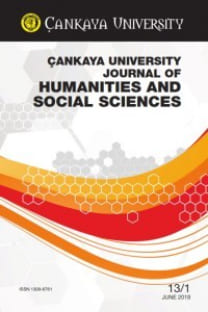Türklerin Etnik Kökenleri, Anadolu’nun “Türk”leşmesi ve Türk Ulusal Kimliğinin Oluşumu
Türkler, Turkik halklar, Türk etnik kimli¤i, Orta Asya, Altay dilleri, Anadolu’ya göçler
Turks Turkic people, Turkish ethnic identity, Central Asia, Turkish nationalism, nation building, Altaic languages,
___
- Adl›, Ayfle, Ulus Devlete Göç. Aksiyon 998, (2014). Altay Grubu Diller, eriflim adresi: http://www.etnologue.com/subgroups/altaic, 1 Eylül 2014. Aray, Osman, The New Independent States of Inner Asia and Turkey’s Policy (Tokyo: Nira, 1999), ss.34-35. Akda¤, Mustafa, Celali ‹syanlar› (Ankara: Medya Takip Merkezi, 1963), ss.250-254. Avc›o¤lu, Do¤an, Türklerin Tarihi, (‹stanbul: Tekin,1978). Barkan, Ömer Lütfi, Türkiye’de Din ve Devlet (Ankara: Türk Tarih Kurumu, 1975). Barthold, Vasily Vladimirovich, Four Studies on the History of Central Asia (Netherlands: Leiden, 1944). Bell, Mark, Racism and Equality in the European Union (New York: Oxford University Press, 2009). Berktay, Halil, Osmanl› Devletinin Yükselifline Kadar Türklerin ‹ktisadi ve Sosyal Tarihi, Sina Akflin (der.), (‹stanbul: Cem, 1995). Brass, Paul, Ethnicity and Nationalism (New Delhi: Sage,1991). Cahen, Claude Osmanl›lardan Önce Anadolu’da Türkler (‹stanbul: E yay›nlar›, 1984). Central Intelligence Agency, World Fact Book, People and Society, Turkey, eriflim adresi: https://www.cia.gov/library/publications/the-world-factbook/geos/tu.html, 14 Haziran 2014 Cinnio¤lu, Cengiz, Roy King, Thomas Kivisild, Ersi Kalfao¤lu, Sevil Atasoy, Gianpiero L. Cavalieri, Anita S. Lillie, Charles c. Roseman, Alice A. Lin, Kristina Prince, Peter J. Oefner, Peidong Shen, Ornella Semino, L. Luca Cavalli-Sforza, Peter A. Underhill “Excavating Y-Chromozome Haplotype Strata in Anatolia” Human Genetics, 114/2,(2004). Çeçen, An›l, Türk Devletleri (‹stanbul: ‹nk›lâp, 1986). Di Benedetto, Giulietta, Ayfle Ergüven, Michele Stenico, Loredano Castri, Giorgio Bertorelle, ‹nci Togan, Guido Barbujani, “DNA Diversity and Population Admixture in Anatolia,” American Journal of Physical Anthropology, 115, ss.44-150. Hambaryan, Azat S., Aghayan Tsatur, (eds.), Hay Zhoghovrdi Patmut’yun [Ermeni Halk›n›n Tarihi] (Erivan: Ermenistan Bilimler Akademisi, 1981), eriflim adresi: en.wikipedia.org/wiki/ Armenian_Genocide. ‹nalc›k, Halil, Osmanl› ‹mparatorlu¤unun Ekonomik ve Sosyal Tarihi (‹stanbul: Eren, 2000). Grousset, Rene, The Empire of the Steppes (Cambridge: Rutgers University, 1970). Golden, Peter, “Some Thoughts on the Origins of the Turks and the Shaping of the Turkic Peoples,” Victor H. Mair (der.), Contact and Change in the Ancient World (Honolulu: University of Hawaii, 2006). Güvenç, Bozkurt, Türk Kimli¤i (Ankara: Kültür Bakanl›¤›, 1995), s.125. Mutlu, Servet, “Late Ottoman Population and Its Ethnic Distribution,” Turkish Journal of Population Studies, 25 (2003). Fisher, Alan, The Crimean Tatars (California: Hoover Institute Press, 1978). Kafeso¤lu, ‹brahim, Türk Milli Kültürü (‹stanbul: Ayd›nlar Oca¤›, 1983). Karafet, Tatiana M., Fernando L. Mendez, Monica B. Meilerman, Peter A. Underhill, Stephen L. Zegura, Michael F. Hammer, “New Binary Polymorphisms Reshape and ‹ncrease Resolution of The Human Y chromosomal Haplogroup Tree,” Genome Research 18/5, (2008). Karpat, Kemal, Osmanl› Nüfusu 1830-1914, Demografik ve Sosyal Özellikleri (‹stanbul: Tarih Vakf› Yurt Yay›nlar›, 2003). Kunt, Metin, “Siyasal Tarih 1300-1600,” Sina Akflin (der.), Türkiye Tarihi Osmanl› Devleti (‹stanbul: Cem, 1995). Matley, Ian Murray, Population and the Land in Central Asia: A Historical Overview, Edward Alworth (der.), (London: Duke University Press, 1994). Mergen, Hatice, Reyhan Öner, Cihan Öner “DNA Sequence Variation in the Anatolian Penissula,” Journal of Genetics, 1/1, (2009), ss.39-47. Mc Govern, William Montgomery, The Early Empires of Central Asia (New York: University of North California Press, 1965). Mutlu, Servet, “Late Ottoman Population and Its Ethnic Distribution,” Türkiye Nüfusbilim Dergisi, 2003, 25, ss.3-38. Noyak, Annop, “After Race: Ethnograply, Race and Post-Race Theory” Ethnic and Racial Studies, 29/3, (2006), ss.411-430. Okladnikov, Alexey, “Inner Asia in the Down of the History,” Denis Sinor (der.), The Cambridge History of Early Inner Asia, (New York: Cambridge University Press, 1990). Özkan, ‹zgi “Central Asia After the Mongol Invasion – Islam and Sedentary Life as a Consequence” Bülent Ar› ve Selim Aslantafl (der.), Osmanl›lardan Önce Anadolu’da Türkler (Ankara: Milli E¤itim Bakanl›¤›, 2006). Özbek, Metin, ‹nsan ve Irk (‹stanbul: Remzi, 1973). Renfrew, Colin, The Puzzle of Indo-European Origins (New York: Cambridge University Press, 1988). Smith, Anthony, State Making and Nation Building [derleyen John A.Hall] (Oxford: Basil Blackvell, 1986). Smith, Anthony, The Nation in History (Israel: Brandeis University, 2000). Tekin, Talat ve Mehmet Ölmez, Türk Dilleri (Ankara: T.C. Kültür Bakanl›¤›, 1995). T-24 Haber Sitesi; 15 fiubat 2014. Tracqui, Christine Keyser, Eric Crubezy, Bertrand Ludes, “Nuclear and Mitocondrial DNA Analysis of a 2000 Year Old Necropolis in the Eygin- Gol Valley of Mongolia,” American Journal of Human Genetics, 73, ss.247-260. Toledano, Eduard, Osmanl› Köle Ticareti, 1840-1890 (‹stanbul: Tarih Vakf› Yurt Yay›nlar›, 1994). TU‹K “Statistical Indicators 1923-1990,” D‹E, Ankara, 1995, s.5. Verdansky, George The Mongols and Russia (London: Yale University Press, 1953). Vryonis, Speros The Decline of Medieval Hellenism in Asia Minor and the Process of Islamization From the Eleventh Century (Los Angeles: University of California Press, 1971). Yinanç, Mükrimin Halil, Türkiye Tarihi Selçuklu Dönemi 1; Anadolu’nun Fethi (‹stanbul: ‹stanbul Üniver- sitesi. Yay›nlar›, 1944). Yuval›, Abdülkadir “Turkification of Anatolia and the Mongols,” Bülent Ar› ve Selim Aslantafl (der.), Osmanl›lardan Önce Türkler (Ankara, Milli E¤itim Bakanl›¤›, 2006).
- ISSN: 1309-6761
- Yayın Aralığı: Yılda 2 Sayı
- Başlangıç: 2004
- Yayıncı: Çankaya Üniversitesi
Kehinde: Floundering between Two Opposite Worlds
TAMAR SHARON, Human Nature in an Age of Biotechnology: The Case for Mediated Posthumanism
TEMMUZ-ARALIK 2013 ARASI TÜRKİYE’DE YAYINLANAN YENi KiTAPLARDAN SEÇMELER
Çankaya University JOURNAL OF HUMANİTİES AND SOCİAL SCİENCES
Sosyal Demokrasinin ‹skandinavya’daki ‹zdüflümü: Ak›nc› Vikinglerden Uzlafl› Kültürüne Geçifl
Rationalization in Weber and Habermas: A Comparative Perspective on a Macrosociological Concept
Personality Measurement and Faking: An Integrative Framework
JEFFREY BISHOP, The Anticipatory Corpse: Medicine, Power, and the Care of the Dying
William Blake and William Wordsworth’s Reactions to the Industrial Revolution
The Anticipatory Corpse: Medicine, Power, and the Care of the Dying
Images of Children in Ian McEwan’s The Cement Garden and William Golding’s Lord of the Flies
